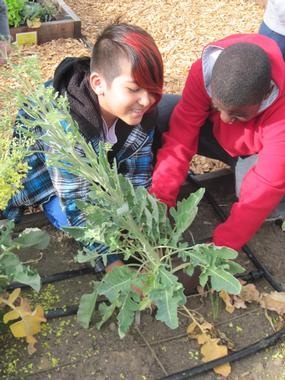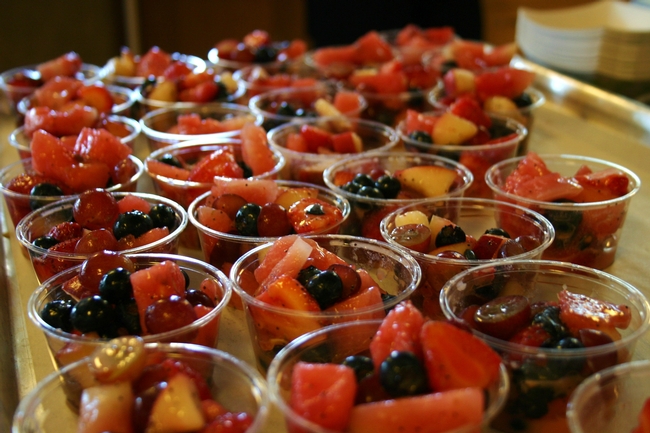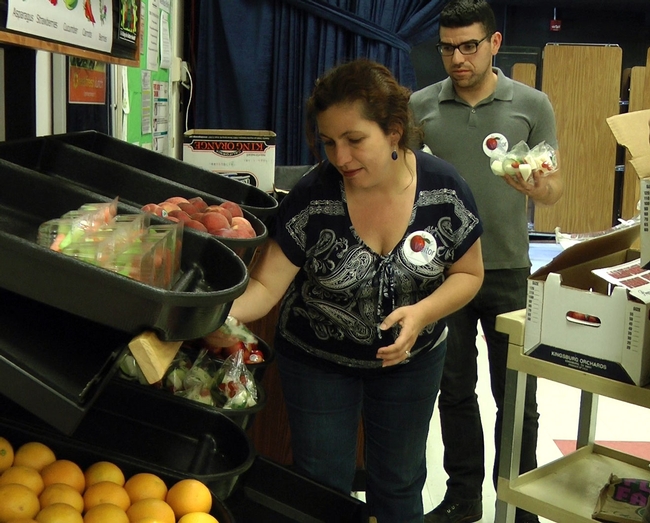Posts Tagged: Terri Spezzano
Shaping Healthy Choices combines approaches to make a lasting impression on kids
You can lead a child to fresh fruits and vegetables, but how do you entice them to eat healthful foods when you aren't watching?
“Simply offering healthy options is not enough to motivate children to make healthy choices,” said Sheri Zidenberg-Cherr, UC Cooperative Extension specialist in the Department of Nutrition at UC Davis.
“Moreover, imposing restrictions rather than providing children with options to make healthy choices can have long-term negative effects,” said Rachel Scherr, assistant project scientist, also in the UC Davis Department of Nutrition.
In 2012, more than one-third of children in the U.S. were overweight or obese, according to the Centers for Disease Control and Prevention. Studies have shown that obese children are more likely to be obese as adults, increasing their risk for health problems including heart disease, type 2 diabetes, stroke, cancer and osteoarthritis. To target the complex issue of eating habits, Zidenberg-Cherr and her UC Cooperative Extension and UC Davis colleagues designed a school-based program and tested it in Sacramento and Stanislaus counties through the leadership of UCCE nutrition, family and consumer science advisors Terri Spezzano and Yvonne Nicholson.
“Parents shared with me that their children are voicing input on meals and asking if they can add fruit to their salads,” a participating teacher told the researchers.
During the first year that the Shaping Healthy Choices Program was implemented in Sacramento County schools, the number of children classified as overweight or obese dropped from 56 percent to 38 percent. The participating students also improved their nutrition knowledge, ability to identify different kinds of vegetables and amounts of vegetables that they reported eating.
“I tried zucchini and yellow squash when I was little and didn't like it, but now I tried it and I love it!” said a 9-year-old student.
The Shaping Healthy Choices Program takes a multifaceted approach, combining nutrition education with family and community partnerships, regional agriculture, foods available on school campus and school wellness policies.
The garden-enhanced, inquiry-based nutrition curriculum was developed by Jessica Linnell, a doctoral candidate in the Graduate Group in Nutritional Biology; Carol Hillhouse, the School Garden Program director at the Agricultural Sustainability Institute; and Martin Smith, a UCCE specialist in the Departments of Human Ecology and Population Health and Reproduction. The family and community partnerships featuring family newsletters were developed by Carolyn Sutter, a graduate student in the Graduate Group of Human Development, and Lenna Ontai, a UCCE specialist in the Department of Human Ecology. Lori Nguyen, a doctoral candidate in the Graduate Group in Nutritional Biology, Sheridan Miyamoto, postdoctoral scholar in the Betty Irene Moore School of Nursing, and Heather Young, dean of the Betty Irene Moore School of Nursing, organized community-sponsored health fairs.
Gail Feenstra, deputy director and food systems analyst for the UC Agricultural Sustainability Institute, helped the schools set up systems to add fresh, locally grown produce to their menus. Jacqueline Bergman, a postdoctoral scholar in the Department of Nutrition, coordinated school-site specific wellness committees.
The UC Cooperative Extension and UC Davis team worked with classrooms to use Discovering Healthy Choices, a standards-based curriculum that incorporates interactive classroom nutrition, garden and physical activity education for upper elementary school students. Teachers partnered with UCCE to incorporate cooking demonstrations to show the connections between agriculture, food preparation and nutrition. To reinforce the lessons at home, Team Up for Families – monthly newsletters containing nutrition tips for the parents – were sent home with the students. School Nutrition Services purchased fruits and vegetables from regional growers and distributors to set up salad bars and prepare dishes made with fresh produce. The Shaping Healthy Choices Program activities were integrated into the school wellness initiatives.
“My students shared things they learned about safe food handling and safety in cooking,” said a teacher who participated in the study. “Parents said their children want to help in preparing meals at home.”
“My daughter is more interested in trying new foods and eating more fruits and vegetables,” reported one parent. “She often surprises the family by making a surprise salad snack for everyone.”
Preliminary analysis shows that nine months after the classroom education ended, the decrease in the students' body mass index percentiles, or BMI percentiles, was sustained. “This is a big deal,” said Zidenberg-Cherr, while cautiously encouraged by the program's success. “We are in the process of analyzing several aspects of the program — the data set is so complex and I have to feel 100 percent confident in our statements.”
Through a partnership with UC CalFresh, the researchers have expanded the comprehensive program to schools in Placer, Butte and San Luis Obispo counties. Determining feasibility for expansion of the program for broader dissemination is planned for the 2015-2016 school year.
This project was funded by grants from the UC Division of Agriculture and Natural Resources and the U.S. Department of Agriculture.
The University of California Global Food Initiative aims to put the world on a path to sustainably and nutritiously feed itself. By building on existing efforts and creating new collaborations among UC's 10 campuses, affiliated national laboratories and the Division of Agriculture and Natural Resources, the initiative will develop and export solutions for food security, health and sustainability throughout California, the United States and the world.
UCCE gets local farm products into children's meals
The San Joaquin Valley produces fruits and vegetables for the nation. Why are the school children living here being deprived of this healthful and delicious bounty?
That’s the question Terri Spezzano asked when she was hired to be the nutrition, family and consumer sciences advisor for UC Cooperative Extension in Stanislaus County six years ago. She made it her mission to get fresh local food in the hands of the county’s youth.
“Kids are eating canned peaches that have come from orchards next to their schools, been shipped sometimes overseas and then back again,” Spezzano said. “That’s amazing to me, when they could walk out the door and literally pull one off the tree. It doesn’t make sense.”
When Spezzano first approached farmers for donations of fresh fruits and vegetables, they balked.
“They would say, ‘Oh, kids won’t eat my vegetables,’” Spezzano recounted. “But it’s been great to watch kids try things like rainbow chard, spinach and bok choy. It turns out, they like it a lot.”
The Stanislaus County farm-to-school nutrition program contains three primary components:
Nutrition education in the classroom
Working with a six-member team of nutrition educators, Spezzano created a unique classroom education series that focuses on crops grown in the county and uses a newsletter to convey information about the local farmers who grow them. Fresh produce and newsletters are delivered each month to classrooms, and children taste the produce with their teachers, learn fun trivia and nutrition facts, and then read about farmers, some who hail from families that have been part of the community for generations.
For example in March, Ratto Bothers Farms donated rainbow chard. For most of the students, it was the first time they tried chard. They were amazed by the vibrant colors and in letters to Ratto Bros asked how they got the colors into the leaves. The kids are now calling rainbow chard “vegetable candy," Spezzano said.
All the details, puzzles, recipes and advice are compiled in “Dirt Fresh News,” a newsletter with a name no youngster can resist. The newsletters go home with the children to inform their parents about their exposure to new produce.
“When you go to the grocery store, ask your mom, dad, grandpa, etc. to buy rainbow chard so you can have your family try it at home,” the newsletter advises. “Make a chard zombie smoothie.” (Find the recipe in the Dirt Fresh News rainbow chard issue.)
Ratto Brothers has been donating to the program since 2008. According to Dirt Fresh News, Ratto Brothers is part of a Stanislaus County family who've been in the area since 1905. The family farms more than 1,000 acres near Modesto. The company’s success through the generations has been due to the enormous pride the family takes in the quality of the herbs, fruit and vegetables that are delivered to their customers, Spezzano said.
Spezzano doesn’t shy away from introducing children to unusual vegetables. One edition of Dirt Fresh News features daikon radishes, large root vegetables with a spicy bite. The word daikon comes from the Japanese words dai (large) and kon (root). The vegetable, which looks something like a giant white carrot, can be peeled and sliced into thin chips, then eaten with dip or tossed into salad.
Spezzano said her children go to local schools and she’s part of the community. Shopping at a grocery store recently, a mother approached with a daikon.
“She asked, ‘This is what you fed my child, right? She really liked it.’” Spezzano said. “It’s been a lot of fun.”
Getting fresh fruit and vegetables into school meals
Turlock Unified School District was already making some progress in getting fresh local fruits and vegetables on school lunch and breakfast menus. Director of Child Nutrition at Turlock Unified School District, Scott Soiseth, was contracting with some farmers and trying to purchase produce at farmers markets. However, the price and logistics became obstacles. Spezzano was part of a group assembled to facilitate the process.
“Nutrition directors are responsible for as many as 50 schools,” Spezzano said. “They can’t be getting bills from a litany of small farmers and having an army of farmers’ trucks backing up to their cafeterias.”
This problem was solved by forging a key partnership with Internet start-up AgLink.com. Created by a farming family, the company facilitates direct sales of fresh fruits and vegetables from numerous small- and mid-sized farms via their e-commerce website. The schools gets real-time information about fresh fruits and vegetables in season and AgLink provides the produce all consolidated onto one bill. Soiseth said he is thrilled with the variety and quality of produce he is getting from local farmers through AgLink.com.
Special “farmers market” tasting after school
Another link in the nutrition education chain takes place after school. The UC Cooperative Extension nutrition program teamed up with the Turlock Unified School District Child Nutrition Education Program and AgLink.com to provide a farmers market experience for the children. After a brief and entertaining presentation by a UCCE nutrition educator, the children line up and fill brown paper bags with a variety of fresh fruits and vegetables.
During a recent farmers market program at Cunningham Elementary School in Turlock, children selected veggie packets that contained sliced and ready to eat green, yellow and red bell peppers, jicama, zucchini and other vegetables. Whole, but small-sized apples, peaches, nectarines, oranges and Asian pears were available for the taking.
“It’s a way to get kids excited about the produce they’re getting at school,” said Marc Sanchez, UCCE nutrition educator in Stanislaus and Merced counties.
No child is forced to eat fruits and vegetables, but they are encouraged to join the “two-bite club,” Sanchez said.
“The two-bite club is for those daring foodies that see something they are a little reluctant to try, but they take two bites. The first bite, they may not like it. Maybe the second bite will be something they like,” Sanchez said. “Regardless of their reaction to it, whether they like it or not, being brave enough to explore the culinary world by trying two bites forever gets them in the two-bite club.”
See more about the after school farmers market in the video below:




